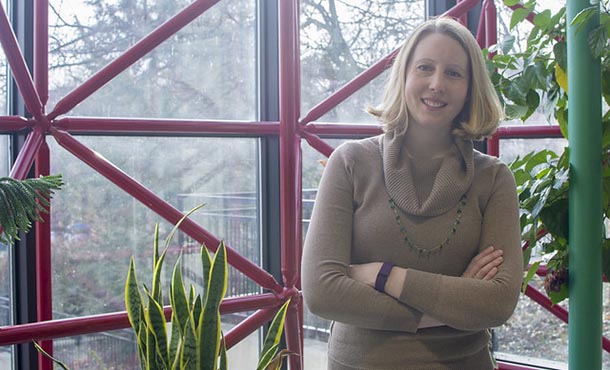
Jacqueline O’Connor, associate professor of mechanical engineering at Penn State. IMAGE: PENN STATE
O'Connor presents at international conference, shares insights in laser diagnostics
7/22/2019
By Erin Cassidy Hendrick
LES DIABLERETS, Switzerland — On June 24, Jacqueline O’Connor, associate professor of mechanical engineering at Penn State, delivered an invited presentation at the Gordon Research Conference (GRC) on Laser Diagnostics in Energy and Combustion Science, highlighting her work in laser diagnostics in engine technologies.
The GRC, “Exploiting and Developing Optical Diagnostics for Combustion and Related Energy Technologies,” was a unique opportunity to share new insights; its purpose was to share and create novel ways to gather measurements from deep inside these chemically reacting systems.
“The idea of these Gordon conferences is to get a small, focused community together to share the newest ideas in the field,” O’Connor said.
O’Connor’s lab, the Reacting Flow Dynamics Laboratory, focuses on the issues affecting reacting flows for energy and propulsion applications like gas turbine engines. To further understand the critical machinery and improve their efficiency, she researches high-speed laser diagnostics and other state-of-the-art experimental techniques to enhance combustion and hydrodynamics.
“These environments produce so much heat that getting instrumentation to survive is difficult,” O’Connor explained. “So, there is a community of scientists who are developing optical diagnostics, with lasers, in order to better understand what’s going on.”
Her presentation, “Understanding Three-Dimensional, Transient Behavior in Engines: Studies Inspired by Work in Diesel and Gas Turbine Engines,” detailed her soon-to-be-published work with mechanical engineering doctoral student, Ankit Tyagi.
“I talked about using these new diagnostic methods in realistic engines,” O’Connor said. “I’m really trying to bridge the divide between two technologies, since few people work across both gas turbine engines and piston engines.”
The invitation to present at this conference was a demonstration of her unique contributions and expertise in this area.
She said, “Since all the talks were invited, it meant a lot to have my peers ask me to do this. It was a nice validation of the work.”
Through the conference, O’Connor returned with impactful feedback from her fellow scientists. As she continues to bridge the gap between these two technologies, these insights will help pave the way for more efficient and valuable combustion engines.
“I was glad to be able to showcase the unique work we’re doing and enhance it by building stronger collaborations and meeting new groups,” she said. “This conference is one of the only places where these people come together, so the experience will be really valuable going forward!”


